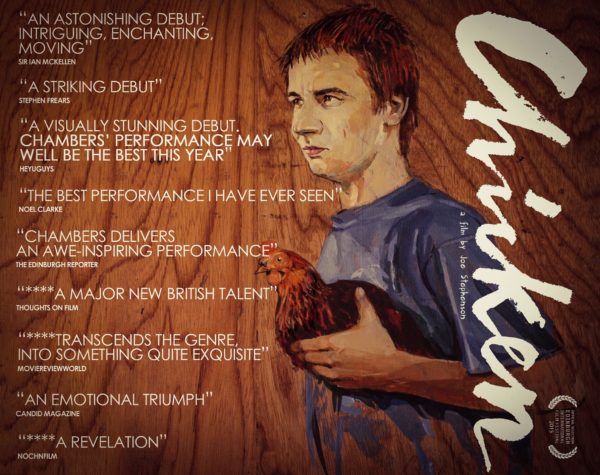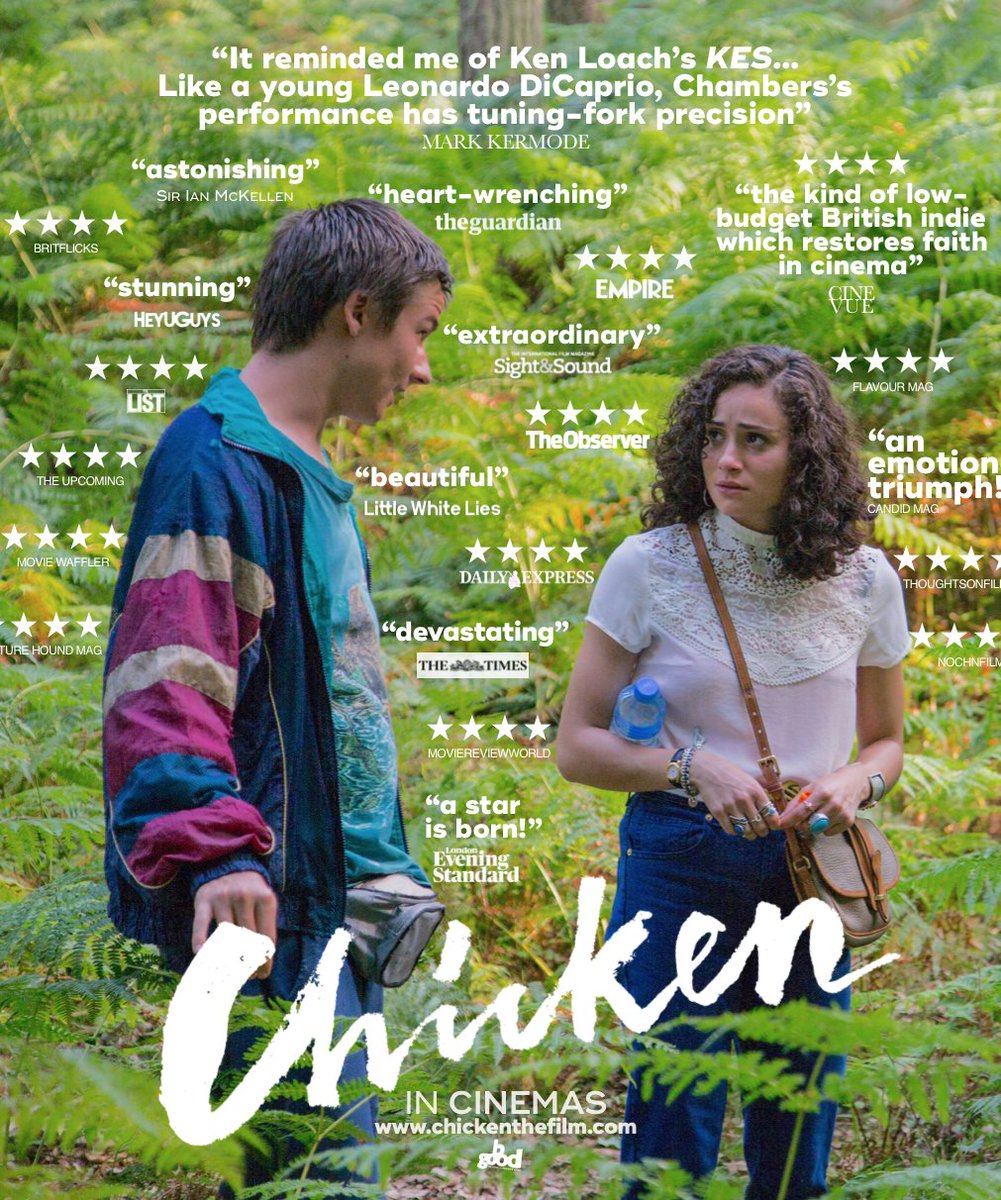Links to refer to:
https://en.wikipedia.org/wiki/Chicken_(2015_film)
https://getrevising.co.uk/diagrams/film-chicken
https://www.bgoodpicturecompany.com/chicken
https://quizlet.com/354561091/csp-chicken-2015-flash-cards/


Overview:
– It is a play by Joe Stephenson
– The film follows 15 year old Richard, who has learning difficulties and often falls victim of brother Polly’s aggressive and violent mood swings
– Richard find is easier to communicate with animals, especially his pet hen, Fiona
– He forms a strong friendship with rebellious seventeen-year-old Annabel, whose family have recently acquired the farm that Polly and Richard live on
– Chicken had its world premiere on 27 June 2015 Edinburgh International Film Festival.
– The film had its international premiere in competition at the 2015 Busan International Film Festival, followed by screenings at the New Hampshire International Film Festival, Giffoni International Film Festival, Cine A La Vista International Film Festival, Tallinn Black Nights Film Festival, Schlingel International Film Festival and Dublin International Film Festival.
– It eventually received a limited theatrical release in the UK on 20 May 2016.
– It was then acquired by MUBI UK, and had its British TV premiere on FilmFour April 2017. It received its DVD and Blu-ray released by Network on 18 September 2017.
– In order to make Chicken, director Joe Stephenson raised £110,000. He raised this entirely through investment by individuals (e.g. rich friends/contacts)
– No funding body (e.g. BFI Film Fund) was willing to fund Chicken
– Raises questions about whether film industry is accessible to lower-income filmmakers
– Adapted from a play by Freddie Machin that originally ran at Southwark Playhouse.
– Filmed in 19 days, almost all external locations so victim to rain, issues with lighting etc.
– Film produced and distributed by a new company set up by director Stephenson: B Good Picture Company.
Awards and Critics Reviews
– Grand Jury Award for Narrative Feature — Joe Stephenson (New Hampshire Film Festival 2015)
– Silver Griffoni Award for Best Film – Generation 18+ (2nd Prize) — Joe Stephenson & B Good Picture Company (Giffoni Film Festival 2016)
Award for Best Film — Chicken (Cine A La Vista International Film Festival 2016)
– Scott Chamber’s performance as Richard got a Special Critic’s Circle mention (Dublin International Film Festival 2016)The film was shortlisted for Best Director (Joe Stephenson) and Best Newcomer (Scott Chambers) by the British Independent Film Awards.
– CineVue praised the film and mentioned that it is “the sort of British indie which restores faith in cinema”.
– Chicken received positive reviews and holds a 100% “Certified Fresh” rating on Rotten Tomatoes based on 12 critic reviews.
– Leslie Felperin of The Guardian gave the film 3/5 stars and said “first-time director Joe Stephenson elicits lively, empathic performances from his small cast.”
– Mark Kermode rated the film at four out of five stars stating that Scott Chambers’ performance is “superb”.
– Anna Smith of Empire magazine gave the film a rating of four stars, responding that the film is “an enjoyable, involving British Drama with and impressive turn from newcomer Scott Chambers.
– With a three-star rating from Cath Clarke of Time Out, she commented that Chicken is “an impressively acted British Drama about a young man with learning difficulties
Technology within Chicken
– Alongside film festivals, new technology was vital to promoting Chicken to a wider audience: Some traditional marketing: trailer, film poster with review quotes etc.
– Social media very important to market film – Facebook, Twitter, YouTube.
– Film available on-demand now; Stephenson hoping for deal with Netflix or Amazon Prime to bring in revenue and find wider audience.
– Film4 shows mainstream films, as well as arthouse films that are aimed at niche audiences. Film4 was a good choice because it meant that a wider range of people would have seen Chicken – as well as those within the target audience.
– MUBI chose this film to be featured on the service because of the fact that the film being critically acclaimed and winning several awards at various film festivals. MUBI most likely wanted to invest in the distribution of Chicken due to its rising success and it receiving more recognition.
– ‘Chicken’ was released in the US exclusively on iTunes early 2018, and continues to maintain its 100% Fresh Rotten Tomatoes rating.
– As well iTunes, it is now available in the US & UK on Amazon Prime
– The director, Joe Stephenson, used the power of New Digital Media (the internet) to keep control over his product through both marketing and distribution
– The critic reviews served as a source of free advertisement for the film
– Official trailer available on YouTube, as well as being embedded in Chicken’s own website. This helps to promote the film virally, encouraging a broader audience as YouTube is accessible globally. Comments and likes help to produce a buzz as well as building a community around the film and providing it with free advertisement (positive comments and likes.)
– It is a form of conventional film marketing, which is Trailers, teaser posters, theatrical posters, billboards, magazine features.
– Chicken used Influencer marketing – where focus is placed on gaining and then using the opinion of influential people rather than the larger target market. It identifies individuals that have influence over potential consumers, and shapes marketing activities around persuading these influencers whose recommendations are known to shape the behaviour of others (Two Step Flow).
– Viral marketing is applied to Chicken. Viral marketing is intending to set up a word of mouth spread by creating pages that appear to be real – that of the Blair Witch is the most famous – where a website made the myth appear real and one that is currently being investigated.
– Chicken uses social media. The website, social media pages, as well as the official trailer on YouTube, are all linked together.
– Website is a portal with links to streaming services; so people can actually see the film (whatever their geographical location – broadens audience)
– Website also links to social media platforms which helps to make the audience feel connected to the product (engages them) and builds a sense of community around it.
– The synergy between all of them is that they are showing the main character in all the trailers and film posters.
– These review are important from people like Mark Kermode because these people are seen to be opinion leaders which people follow.
– Chicken uses social media to create and maintain interest in the film because people use social media a lot so they can connect with them easily.
– Both the poster and film trailer use the same font for the title ‘Chicken’. The colour scheme is also the same and the picture used on the film poster is from one of the scenes shown in the trailer. Furthermore, both the poster and trailer also feature film reviews about the film and the names of the film festivals where the movie was shown.
– The Chicken twitter account is constantly tweeting. Recently, they had been tweeting a countdown for the release of the film in the US and Canada. This maintains the interest of the film as audiences are constantly reminded of the film.
– The Chicken Facebook page uploads pictures and videos of scenes from the film. This intrigues the audience. Furthermore, they also upload reviews from film critics, such as Mark Kermode and magazines such as Empire.
– The Chicken Facebook page has liked the pages- @ArtHouseCrouchEnd, @Everymancinemas, @LittleWhiteLies, etc. This suggests that the target audience of the film are middle class white men and women who enjoy art house films, where the cinematography has been taken in to account and the story line is very different from typical cinema movies.
– The key purpose of the website is to link people to where they can watch the movie depending on where they live. This includes iTunes for those in the US and Canada and Amazon Instant Video, Film Doo and Volta for those in the UK and Ireland. This suggests that the influence of new technology means that audiences mostly stream and watch movies on demand rather than going out and buying a DVD.
Livingstone and Lunt and Chicken
– Chicken is a film in the style of social realism. It depicts two brothers, the younger of which is disabled, who run into conflict with the owners of the farmland on which they live.
– The BBFC works to protect audiences from discriminatory language regarding disability.
– Due to the depiction of a sensitive topic and the particular narrative involved, Stephenson may have run into issues when attempting to tell the story without using such language in the script, particularly the dialogue of the new landowners.
– This is representative of the struggle theorised by Livingstone and Lunt.
Curran/Seaton and Chicken
– If we consider the marketing of Chicken and its political values, those of which are oppositional to many of those in the mainstream media industry, we can see that despite the limited funding, creativity in the marketing indicates the cultural pessimism of Curran does not mean products outside such media institutions have to fail or cannot compete at a different level for audiences.
– It could be argued that the fact the film is outside the mainstream of media institutions allows it greater degree of freedom in its message and marketing.
Chicken Mind Map

